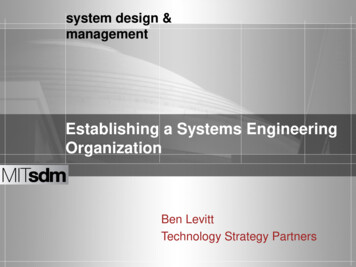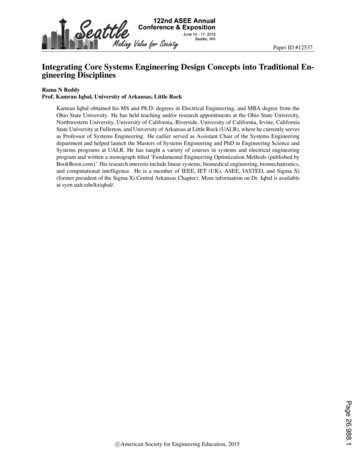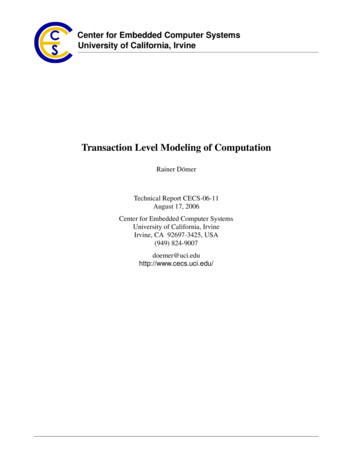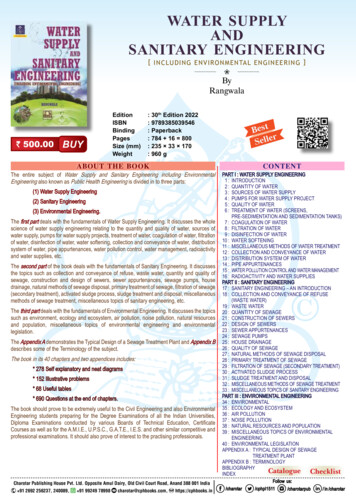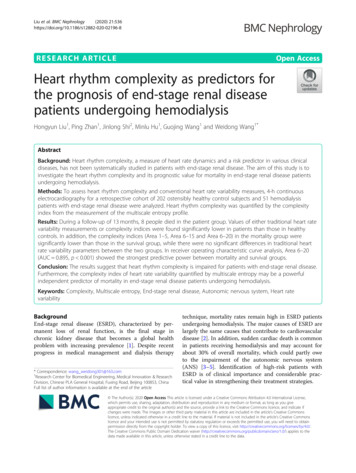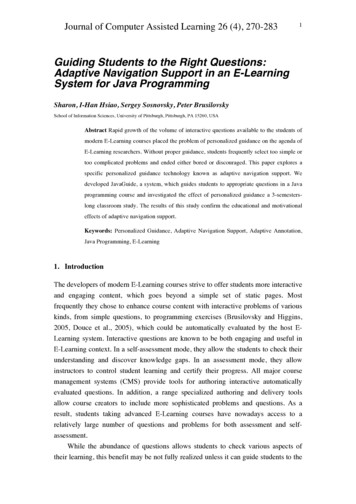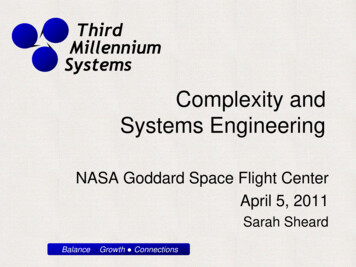
Transcription
ThirdMillenniumSystemsComplexity andSystems EngineeringNASA Goddard Space Flight CenterApril 5, 2011Sarah SheardBalanceGrowth Connections
AgendaBalanceGrowth Connections Systems engineering today Complexity in science Complexity spectra Complexity in systems engineering Types and measures2ThirdMillenniumSystems
SE and ComplexityBalanceGrowth Connections “in the 1960s. engineers, scientists, andmanagers. had found the systems approacheffective in responding to physical andorganizational complexity.”–T. Hughes, Rescuing Prometheus (1998) “What has led to.systems engineering as aseparate function in organized creativetechnology? .increasing system complexity.”– A. Hall, A Methodology for Systems Engineering (1962)3ThirdMillenniumSystems
Systems Engineering Is?BalanceOrg ChartsTitlesRequirementsTwelve DesignerSE Roles AnalystV&VLogisticsGlueThe SE Vee (Life Cycle)Define Needs andOperationalConceptCust. InterfaceTech ManagerInfo ManagerProcessCoordinatorClassified AdsVerify SystemDesign SystemIntegrate System Know the problem, thecustomer, and the consumer. Use effectiveness criteria basedon needs to make systemsdecisions. .ImplementSystemThree Types of Implementation4ComplexityType 1DiscoveryThe SE Engine(Mil-Std-499B)InformationTechnology SESoftware and computersystem developmentdone with an eye to thelarger systemSE Principles & HeuristicsValidate SystemDefine SystemRequirementsGrowth ConnectionsUnprecedentedProblemsType 2Program SEUnprecedentedSolutionsType 3 ApproachLife CycleSE of ComplexSystems (CxSE) We don’t have goodpatterns yet Heuristics, based onresearch Principles, based onexperience asextended byresearchThirdMillenniumSystems
Systems have evolvedBalance5Growth ConnectionsThirdMillenniumSystems
Source: Monica Farah-Stapleton, IEEE SOS conference, 2006Used with permissionArmy SOS6Balance Growth ConnectionsThirdMillenniumSystems
Definition of Complex SystemBalanceGrowth Connections A system not describable by a single rule.Structure exists on many scales whose characteristics are not reducible to only one level ofdescription. A system exhibiting unexpectedfeatures not contained within its m) A system with self-organization, analogous tonatural systems, that grows without explicit control,and is driven by multiple locally operating, sociotechnical processes, usually involving adaptation.(Adapted from Braha et al. eds., 2006)7ThirdMillenniumSystems
The Complexity QuagmireBalanceGrowth fMarketsSmall ptiveSystemsComplexity Edge of ChaosAreScale-FreeNetworksLead toDescribeHaveArePower Systems
A View of the Short-Term OrderLong-Term OrderChaosShort-Term OrderLong-Term DisorderGrowth ConnectionsDisorderRandomnessShort-Term DisorderLong-Term DisorderSource: competition/flores.htmSource: allpaper-fractals2.php9ThirdMillenniumSystems
Complexity and Systems EngineeringBalanceGrowth ConnectionsDecomposableOrdered systemsComplex systemsSystems10ThirdMillenniumSystems
Spectra -1BalanceLess ComplexClosed systemsClockwork systemsOrganizedWeakly integrated systemsCentral controlSingle agents/pairs of agentsTechnical11Growth ConnectionsMore ComplexOpen systemsSwarm systemsSelf-organizingHighly integrated systemsDecentralized controlInfinities of agentsSocio-politicalThirdMillenniumSystems
Spectra -2BalanceGrowth ConnectionsLess ComplexMore ComplexUnderstandableDifficult to StableUnstableLinearNonlinearLoose couplingControllability12Tight couplingAdaptabilityThirdMillenniumSystems
Spectra -3BalanceLess ComplexGrowth ConnectionsMore ComplexStrict hierarchiesNetworksTactical behaviorStrategic behaviorSimple behaviorEmergent behaviorClear cause and effectSingle scaleReductionism works13Unclear cause/effectMulti-scaleHolism requiredThirdMillenniumSystems
What’s the difference?BalanceMany piecesNonlinearEmergentAdaptiveChaoticTightly 4Growth ConnectionsUncertainDifficult to understandUnclear cause and ble, unmaintainablePoliticalTakes too long to buildCostlyThirdMillenniumSystems
Complexity Contributors and ResultsBalanceTechnical Characteristics/System Characteristics/Objective ComplexityCognitive Characteristics/Subjective ComplexityUncertainMany piecesNonlinearGrowth ConnectionsDifficult to understandEmergentUnclear cause and effectAdaptiveChaoticUnpredictableTightly ityUncontrollableUnstableUnrepairable, unmaintainableTakes too long to buildOpenCostly15Multi-ScaleThirdMillenniumSystems
Manage Complexity: SE and ComplexityBalanceMany piecesEmergentNonlinearAdaptiveChaoticTightly ti-Scale16Growth Connections Planning, and monitoring toensure compliance Control Hierarchy and modularization Decomposition (Reductionism) Order.predicting and avoidingchaotic regimes Gaussian distributions Trade Studies Requirements Architecture,Stable intermediates Vanquish complexityThirdMillenniumSystems
How SE Could Better Address ComplexityBalanceMany piecesEmergentNonlinearAdaptiveChaoticTightly ti-Scale17Growth Connections Planned co-evolution with environment Understand decentralized control Use modularity and hierarchy along withnetworks Decomposition (Reductionism) whereappropriate Intensive modeling and simulation Predicting ordered and chaotic regimes intechnological systems and developmentsystems Managing the boundaries of safe state spaces Power-law distributions as well as Gaussian Trade Studies, Requirements,Architecture,Stable intermediatesThird Invoke social sciencesMillenniumSystems Manage complexity as risk
Dissertation TopicBalanceGrowth Connections Correlation of Measures of Complexity forSystems Engineering with Measures ofProgram Success Goal: determine a small set of complexitymeasures that predict program success Or none at all! Measure complexity First: know what it is! Define “for systems engineering” Measure program success18ThirdMillenniumSystems
What Is Measured?BalanceGrowth ConnectionsConfiguration Complexity - Number of levels ofcomponents nested within a boundary orenvironmentComplicatedness/Functional Complex-ityNumber of different elementarycomponents through specific interactionsComplicatedness/Functional ComplexityNumber of different elementary componentsthrough specific interactionsProduct complexity. Number of subsystemsof a physical deliverable of the project,their interrelationshipsSubjective Complexity Based on humanperception; related to observers’ own thinkingStatistical Complexity Statistical measures ofstructure or patternAlgorithmic/Deterministic Complexity Based oninformation theory, use mathematicalcomputation to measure the algorithmic contentof dataInterface Complexity. An interface of acomponent in isolation19Ref: Young, Farr, Valerdi: Role ofComplexities in SE Cost EstimatingProcesses CSER 2010Dynamic Organizational complexity.Pattern and rate of change in organizationalenvironment, such as business processes,organizational structuresInter-Component Complexity. Interactionsof components at the system levelImplementation Complexity. Complex-ityof creating and implementing componentsbeyond interface complexity, such asprogram codeThird.MillenniumSystems
“Atomic Pieces” of Complexity RepresentationBalanceSystem DynamicsNetworksGrowth cCabe ComplexityVerticesConnectionsEdgesSocial NetworkingSubsystems or ElementsInterfacesPeopleSystemsEngineeringSystem AnalysisTasksDependenciesProject ManagementEntitiesRelationships20Model Things RelationshipsThirdMillenniumSystems
Theoretical types of complexityBalanceObjective complexityThings(Systems, products)Structuralcomplexity1subtypesGrowth ConnectionsStructuralcomplexity: Size2 Structural tive complexity21InhomogeneityDynamic4 complexity:short termsubtypesEnvironmentCognitivecomplexity3 Structural tyDifficulty, problems,confusion, risk, control,prediction, uncertainty5Dynamiccomplexity:long termThirdMillenniumSystems
Complexity related toa project trying tobuild a systemOrganizationevolvesEstablishorganizationHave manypeopleUnderstandenvironmentStructure &behavior of thesystem’selementsUnderstand goalsPlan effort vsbudgetSystem has manyelementsAssess riskPeople domanytasksTasksbuildelementsDesign systemDesign elementsand interfacesIntegrate SystemPeople interactComplexity related toan environment inwhich the system shalloperateComplexity related toa technical systemIn a possiblyunknown wayThe elements areinterconnectedIn a structureWith manylevelsIn a patternVerify meetsgoalsPeople formchanging teamsSystem behavioremerges fromconnectedelementsEmergence isoften surprisingThe elementsare different(diverse)Many pathsthrough thesystemNot fullyunderstoodIntending toprovide a desiredintervention inEnvironmentalsystem (WayThings Are)In operation,system affectsWay Things AreHas many highlyinterconnectedelements andresultingbehaviorsEnvironment isan ongoingsystem: TheWay Things AreHas perceivedproblemsElement technology maturityreduces riskComputer,software, andprogrammingExpertise neededAll these things change over timeThere is information (data) about all these thingsOften unseenand unpredictedPeople createmodeling toolsand cognitivesupport toolsHas manystakeholdersMultiple peoplework togetherSome of whomfund the systemdevelopmenteffortPeople nvisionedSolution andbudget assignedto organizationPresumably animprovement inWay Things AreOver time,Way Things AreevolvesDeliver systemWay Things Areaffects systemand its perceivedvalueComplexity existing inthe mind of thehumansNew Way ThingsAre includes“side em,behaviorUncertainty predicting changesin environment,system, behaviorUncertainty andunpredictabilitycause risk
Complexity related toa project trying tobuild a 13Establishorganization9Structure &behavior of thesystem’selementsUnderstand goals22Assess riskPeople domanytasksDesign system9People interact11Design elementsand interfacesThe elements areinterconnectedIn a possiblyunknown way17Integrate System29In a structureWith manylevels1Intending toprovide a desiredintervention inEnvironmentalsystem (WayThings Are)2Verify meetsgoalsPeople formchanging teamsSystem behavioremerges fromconnected18 elements23 Emergence isoften surprising15Not fullyunderstood1024In a pattern3Environment isan ongoingsystem: The WayThings AreHas perceivedproblemsIn operation,system affectsWay Things AreAll these things change over time192113 14 27 31There is information (data) about all these things56People createmodeling toolsand cognitivesupport toolsOften unseenand unpredictedHas manystakeholders2528Some of whomfund the systemdevelopmenteffortSolutionenvisionedSolution andbudget assignedto organizationPresumably animprovement inWay Things AreOver time,Way Things Areevolves7Way Things Areaffects systemand its perceivedvalue14 12Computer,software, andprogrammingExpertise neededComplexity existing inthe mind of thehumansMultiple peoplework together28People arecognitivelylimited 20Confusion,uneasiness32Deliver systemElement technology maturityreduces riskMany pathsthrough thesystem2616TasksbuildelementsThe elementsare different(diverse)System has manyelements308Has many highlyinterconnectedelements andresultingbehaviors31Plan effort vsbudgetHave manypeopleComplexity related toan environment inwhich the system shalloperateComplexity related toa technical systemNew Way ThingsAre includes“side tem,behaviorUncertainty predicting changesin environment,system, behaviorUncertainty andunpredictabilitycause risk
Complexity Measures Winnowing downmeasures to asurveyable set Seek correlation Looking for historicalprograms to interview Need both successfuland unsuccessfulprograms (late, veryoverrun, cancelled)24Growth ConnectionsProgram TimelinessBalanceComplexity Measure #13ThirdMillenniumSystems
Survey Questions for DissertationBalanceGrowth Connections Goal: Determine which complexity measuresmatter Asked 50 projects: How complex was it? ( 30 measures, 5 bins) How successful was it? (cost, schedule,performance/quality) Your role and contact information Program name not required Link to questions sSurveyThirdMillenniumSystems
Balance26Growth ConnectionsThirdMillenniumSystems
Measures in surveyBalanceProjectCost, annually and totalRelative sizeDuration of projectReplanned?Use PERT, Risk Mgt, Agile, Lean, Double Loop, SetChange packages in limboTask dependenciesProject controlStaff skills# Decision makers# Government organizations# Contractor organizationsFog of conflicting data and cognitive overloadEstimates were goodShort-term vs Long-term focus27Success, generalDelivered a productCost rel. to planSchedule rel. to planPerformance rel. to planGrowth ConnectionsSystemSubsystemsNo. RequirementsNo. Requirements, DifficultArchitecture precedenceRequirements conflictRequirements/cost/schedule conflictTechnology maturitySystem evolutionContractorsEase of meeting user/sponsor expectations# SponsorsStakeholder conflictChange in stakeholder needsESE ProfilerThirdMillenniumSystems
BalanceGrowth ConnectionsBackup slides28ThirdMillenniumSystems
Complexity Types from SE Literature IBalance Growth Connections Requirements and problem space Conflict How many people would you have to get into aroom to understand the whole problem? Technical feasibility Match of needs to plan Skills Domain knowledge Gap between know and need to know How long to come up to speed?29ThirdMillenniumSystems
Complexity Types from SE Literature IIBalance Growth Connections Technology Maturity Technology and interfaces TRLs Computer and language Socio-Political subcategories Organizational instability Organizational structure Stakeholder cohesion Management task Testing30ThirdMillenniumSystems
Existing Measure for SocioPoliticalBalance Growth ConnectionsEnterprise Systems Engineering ProfilerTM of MITRE Traditional program domain Well-boundedWell bounded problem Predictable behavior Stable environment Transitional domain Systems engineering acrossboundaries InfluenceI flvs. authorityth it 1Messy frontier Political engineering (power,(powercontrol ) High risk, potentiallyhigh reward Foster cooperative behaviorThirdMillenniumSource: Renee Stevens, “Engineering Enterprise Systems: Challenges andSystemsProspects,” Presentation to DAS XIII, 2006.
Systems How SE Could Better Address Complexity Planned co-evolution with environment Understand decentralized control Use modularity and hierarchy along with networks Decomposition (Reductionism) where appropriate Intensive modeling and simulation Predicting ordered and chaotic regimes in technological

